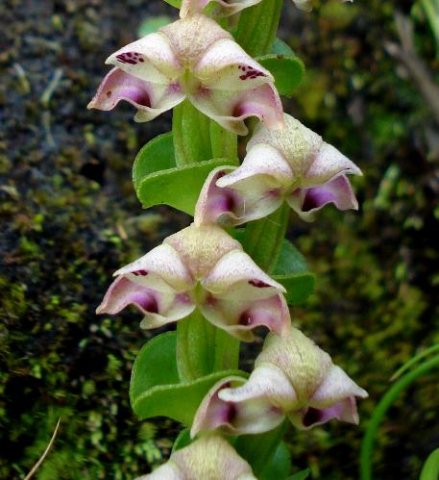Disperis

Author: Ivan Lätti
Photographer: Judd Kirkel Welwitch
Disperis is a genus of slender ground orchids or terrestrial orchids, part of the Orchidaceae family. There are two subgenera, Disperis and Dryorkis. Commonly called witch orchids and in Afrikaans moederkappies (mother bonnets), the plants are tuberous perennials. The root tubers are ovoid, sometimes growing in shallow soil or forest leaf mould. The stems are sometimes hairy.
The plants bear one to a few lanceolate or ovate leaves. In some species the leaf arrangement is alternate, in others (fewer), the leaves grow opposite, in pairs.
The inflorescence is a loose, stem-tip spike, or the flowers appear solitary. The flower-stem bracts may be leaf-like. Flower colours are white, yellow, green or pink.
The three sepals are free, the median one above often helmet-shaped and flanked by the two lateral petals in forming a deep hood. The median sepal sometimes has a spur or sac-like protrusion. The lateral sepals are oblique, part of them mostly conically spurred, club-shaped or sac-like. The generic name, Disperis, is derived from the Greek words dis meaning double and pera meaning pouch, referring to these twin spurs on the lateral sepals.
The shape of the lateral petals vary, sometimes sickle-shaped or ear-shaped. The median petal or lip is often clawed, meaning in many species clawed, dilated above and ascending along the gynostemium or column to which it is fused at the base. There is a large lip appendage directed to the tip of the median sepal.
Plants of the Disperis subgenus have undivided lip appendages and are pollinated by oil collecting bees of the Rediviva genus. The oil is produced on the lip appendage, usually near its tip. The twin spurs on the sepals mentioned earlier therefore play no role in pollinator reward or pollination. They only served to protect the rostellum arms during the budding phase.
On the gynostemium or column, the anther lobe cavities are parallel and horizontally flexed. There are two pollinia with separate sticky glandular patches. The rostellum separating the male and female parts on the column has a large central lobe and lateral arms.
The fruit is a ribbed capsule, cylindrical or ovoid in shape.
There are about 84 Disperis species in Africa, Madagascar, other Indian Ocean islands and Asia, 26 of them occurring in southern Africa. The tropical zone species often grow on forest floors, the southern African ones mostly found in grassland or fynbos.
The plant in picture is Disperis renibractea (Liltved and Johnson, 2012; Leistner, (Ed.), 2000; Manning, 2009; Wikipedia).

